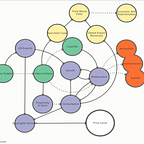Degrowth is the Future.
The question is not whether we will face degrowth, but what we choose to degrow.
(I will keep this short by linking to previous articles.)
Degrowth has the issue of being defined or rather framed by what it is against rather than what it is for.
But in our present/future environmental situation I would argue degrowth is inevitable. We can choose what we degrow, not whether we degrow.
Let’s compare two potential plans for the future: the degrowth plan and the status quo plan. The twist is that both will be framed in terms of what they seek to degrow.
Degrowth:
As stated above degrowth does not believe in abstractly and arbitrarily reducing GDP as an end goal. Segments of the economy which are necessary and benefit humans should continue to grow, while industries which do not benefit lifespan or happiness should be reduced such as “fossil fuels, SUVs, advertising, planned obsolescence, McMansions, arms, industrial beef, private jets, etc).” I would add Fast Fashion and crypto which the global south has already taken the lead in banning. Overall this reduced consumption should be justified by more leisure which would also reduce emissions.
Degrowth policies must not happen in isolation; they must be paired with various social programs to reduce the inequality that our resource use perpetuates. (Job guarantees/UBI, third world debt relief/colonial reparations etc.) There is no shortage of work to be done in preparing for climate change.
So in sum degrowth says we should reduce the following:
- Fossil Fuel Consumption
- Advertising
- Planned Obsolescence
- The Military Industrial Complex
- Industrial Beef
- Weekly Working Hours
- Global Inequality
While raising:
- Renewable Energy Output
- Public Transportation
- Climate Adaptation Infrastructure
- First and Third World Social Programs
The critics of degrowth say this is too costly and that we should stick to the plan of >2 degrees Celsius.
We should instead degrow the following:
- The pH of the ocean.
- The amount of arable land on earth
- Agricultural yields
- Fresh water supply
- Coral reefs/ Fish populations
- Ice caps/ Ice sheets
- Planetary Albedo
- Number of animal species on Earth
While raising:
- Global temperature levels
- Incidence/Severity of floods/hurricanes
- Incidence/Severity/Duration of droughts/heat waves
- Wet Bulb Temperatures
- Number of global refugees
- Wildfires
- Water wars
- Famine
- Mosquito populations/Malaria Spread
- Sea Levels
- Permafrost thaw/methane in the atmosphere
- Arctic trade routes
- Hopefully some pretty sensational geoengineering.
My takeaway from framing both climate plans this way is that degrowth may no longer feel quite as radical. As well, the status quo may not be the safe, stable, sensible path forward.
Postscript:
In this article I have committed a logical fallacy known as the false dichotomy. There are two positions I’ve omitted.
Climate denialists are not represented, and neither are the technological ex machinists. I really hope they’re right, but once again they are gambling with the future of organized human life on earth.
